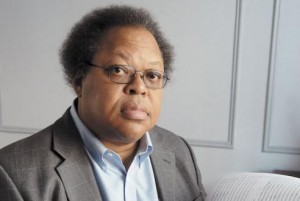Yesterday, we had the pleasure of reading pieces by three University of Chicago students during an open session in Fulton Hall. Moderated by Director of Performance Studies Barbara Schubert, we gave feedback and advice to the composers and fielded questions from the lively observers. Here's a picture we snapped of us tuning while the audience filed in from a short break:
The Old Man and the C: George Lewis
Canon Fodder: Adagissimo
Brian Ferneyhough: Adagissimo (1983)
- Brian Ferneyhough was born in Coventry, England in 1943. He currently teaches at Stanford University.
- Adagissimo was written for the Arditti Quartet.
- My other favorites by this composer are Terrain and La Chute d'Icare.
Brian Ferneyhough has gained a reputation for being a composer of hard music: hard to play and listen to. This piece, while certainly not easy for the performers, is a great in-road to his style due to its extreme brevity. Give it a chance, you'll only need two minutes.
The broad brushstrokes of his pen remind me of an early painting by Jackson Pollock that I love. It's full of emotional depth, but bursting with flourish, energy and wild virtuosity. Oddly, I even think of a short story by David Foster Wallace. Like Wallace, Ferneyhough has a masterful command of his technique, and is teeming with material to work with, but there's also a deeply soulful underpinning to the music.
The violins splash colors as the work opens, revealing the dolorous music of the viola and cello below. The lower voices lay it on thick with dark browns and dirty navy blues while the violins sparkle in golden threads.
If you're interested in more of the technicalities, the YouTube notes provide information from the composer.
The Old Man and the C: Strad Science
Last November, NPR ran a piece on Dr. Steven Sirr and violin maker Steve Rossow, two gentleman using a CT scan of a 307-year-old Stradivarius in an attempt to recreate it. It’s likely that most string players joined me in the commencement of eye-rolling upon hearing this story. For as long as I can remember, luthiers have tried to recreate the storied violins with little, or more often, no success. Replications of varnish, sourcing of era- and geographically-specific woods, even manufactured divots and scrapes to mimic the originals have failed to parallel the aural color palette of the Strad. So it is far from surprising that a CT Scan is unable to unearth the long-searched-for “x factor.”
More recently, on January 2nd, 2012, NPR aired another piece that put forth the proposition that the entire enterprise may be moot. A double-blind study led by Claudia Fritz of France's National Center for Scientific Research assembled seventeen professional violinists (evidently selected from the International Violin Competition of Indianapolis), two Strads, a Guarneri and three modern instruments. Shockingly (insert gasp here), only three were able to identify a Strad by sound alone.
So case closed. String players are no better than those who would burn cash on a handbag simply because of the initials patterned across it.
Well, perhaps not. In a study following the true tenants of the scientific method, all factors must be considered variables and each must be tested against a control. Where did this experiment take place? A hotel room. As any ambitious musician who has flown across state lines for an audition is aware, a hotel room has the unique effect of making even the finest instruments sound about as sublime as the restroom at an IBS convention.
Secondly, who are these esteemed violinists? What is familiarity of each with centuries-old instruments? We can assume they are capable players, but if they, like most, have not spent their respective careers playing on three million dollar violins, what could they have been listening for? The best sound, probably.
My own hunt for a viola took six years and stretched from Los Angeles to Manhattan. Questing for the ideal sound in an instrument is an altogether different beast than what Fritz was exploring, but my search had the unanticipated benefit of an exposure to violas of myriad time periods and price tags. It did not begin as a quest for an old Italian specimen, but that is where it culminated. In the process, I took everything from a $900,000 Amati to a $12,000 Vanna So through the twitter of “Midsummer Night’s Dream” as well as the geometric launch of “Der Schwanendreher” (among many other works). By the end of the excavation, the one solid conclusion at which I arrived was that price is meaningless. That Amati was nothing more than a piece of overpriced furniture. What was clear, though, was that no modern viola I played approached the nuance and depth of the best of the old Italians.
Which bring up the final point: where does the aforementioned Strad fall in the spectrum of Strads? All are not created equal, as a colleague of mine discovered when she was awarded one…and promptly, if sheepishly, returned it.
Just as with any pseudo-scientific claims that your child will be cooing Quantum Theory if subjected to Mozart in utero, the research here in question is a far cry from that on which we depend to knock out a pneumonia or send protons careening into one another. All that has been concluded in this study is that this particular cadre of violinists couldn’t identify a Strad. What is also true is that Good Strad = Good Strad, and Bad Strad = Bad Strad. Finally, it is most certainly true that these genius-carved violins cost too damn much. If you believe anything beyond that, Dietmar Machold has a violin to sell you.
Canon Fodder: Hyla 4
[dropcap_1]W[/dropcap_1]elcome to the 2nd edition of Canon Fodder, a series dedicated to presenting string quartets that deserve to be heard. Lee Hyla is a close friend of quartet, and he's got a new piece in the pipeline for us. Hope you like our old favorite by him, with video from our recent performance -Austin
Lee Hyla: String Quartet #4 (1999) - www.leehyla.com
Lee Hyla was born in Niagara Falls in 1952, he currently lives in Chicago, IL and teaches at Northwestern University.
First performance: 9/23/99 at University of Mass. Amherst. Written for the Lydian String Quartet, commissioned by New England Presenters
My other favorites by Lee are We Speak Etruscan and Pre-Pulse Suspended.
As a second part to this series on contemporary works for string quartet, I thought I'd continue with another Spektral favorite. I think you'll see from the video below that this piece takes full advantage of the expressive and virtuosic possibilities from each chair of the quartet.
Keep an ear open for those spots where Lee has the quartet playing in different tempos. Particularly at 1:53 you can hear that transition from "together" to "apart" as the cello picks up its own faster tempo, as well as the large section in duos (cello/vln. 2 and vla/vln 1) starting at 3:34. The conversation happens from so many angles, pairs, and tones of voice from each instrument throughout the piece!
Lee's music is a continual joy for me to listen to and perform because of its integrity to his own personal voice (he reminds me of the musical equivalent of Lenny Bruce). His combination of disparate musical impulses into a coherent language that's immediately "Lee's Music" would make Stravinsky or Beethoven giggle.
Canon Fodder: Dig Absolutely
[dropcap_1]W[/dropcap_1]elcome to the first of my Canon Fodder, a series dedicated to presenting string quartets that deserve to be heard. I thought I'd start with a personal and Spektral favorite, accompanied by a brand spankin' new video by us. I will be featuring a new quartet each week, and I'd love to hear your thoughts in the comments below. -Austin
Christopher Fisher-Lochhead: Dig Absolutely (2010) - www.cflmusic.com
Chris was born in Lewiston, ME in 1984 and currently lives in Chicago, IL where he is pursuing a Doctoral degree in Composition at Northwestern University.
"Dig Absolutely" is dedicated to Laurel Borden and was premiered at the Manhattan School of Music on Feb. 6, 2011.
My other favorite pieces by Chris were written for me, of course! I love his string writing and think his solo violin pieces "water(l)ily" and the piece I'm premiering next month, "Belles Letteres" are fantastic. Also, "Gouache: 'Runcible Spoon" is almost as fun to play as "Dig".
The opening of "Dig" spins out a twisting line of music that weaves between the upper three voices of the quartet. The patience of this piece as it waits to burst the initial bubble of energy is quite remarkable. When Russ enters just after the 2:00 mark all the energy flies into the air, fragmented but not fully released.
In this heightened realm of expression where we land - floating above the earthy, gritty gestures of the opening - there is a sense wonder at the sounds a string quartet can make. Harmonics build upon each other and swish by like insects.
By 3:20 all the angst of the opening has been filtered out by the air of this fragile nocturnal region. The journey from the dense forest of rhythmic counterpoint and metric instability at the beginning to this place of rest is one worth taking more than once.
From this point, the unification of this newfound metric stability with the sighing and expressive gestures of the opening builds up to the climactic moment the opening's energy was begging for. But, afterward…why is Doyle left alone, journeying through the terrain of fragile harmonics by himself? A fascinating short story.


